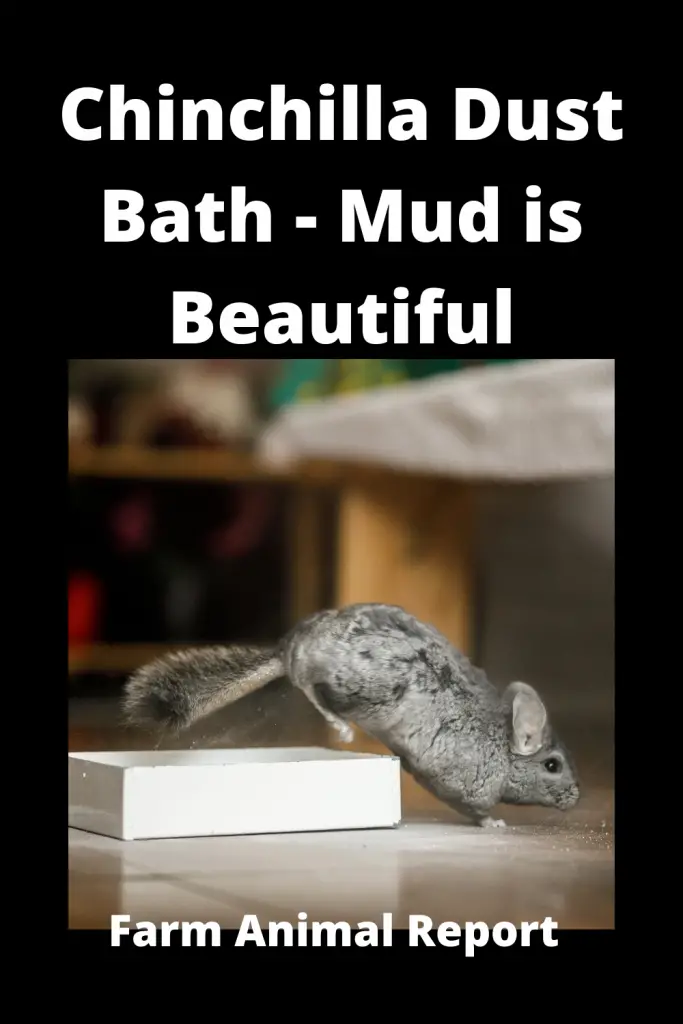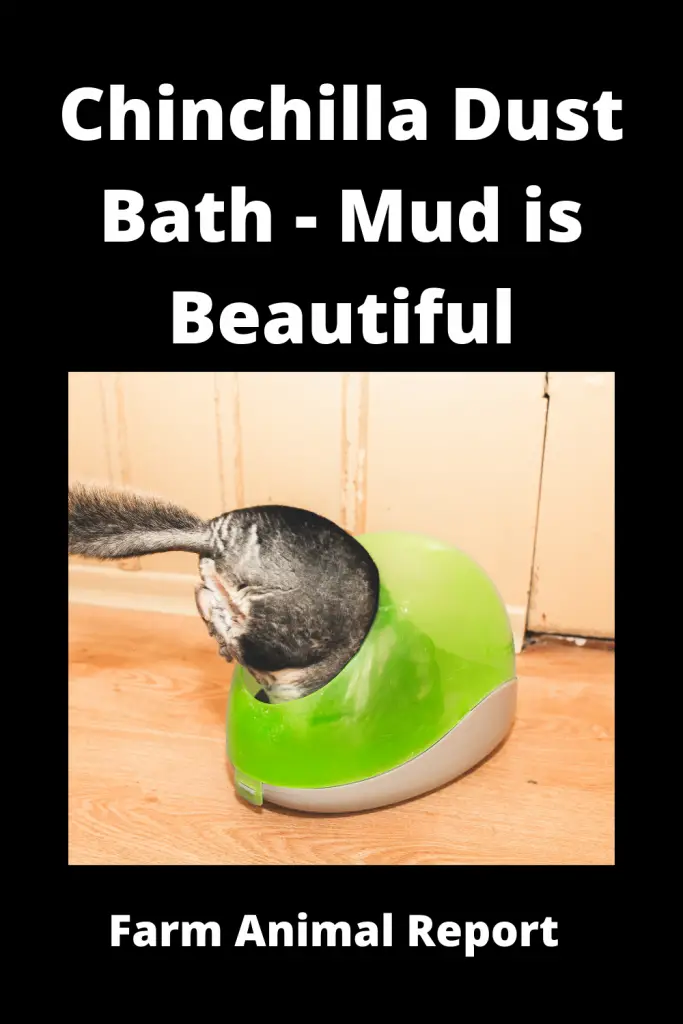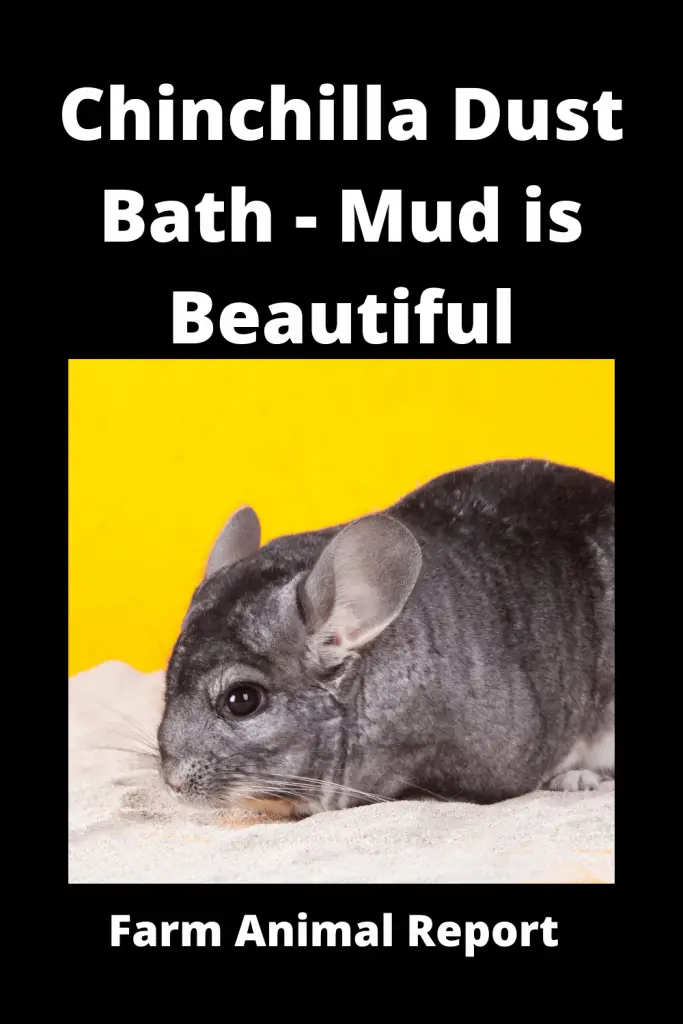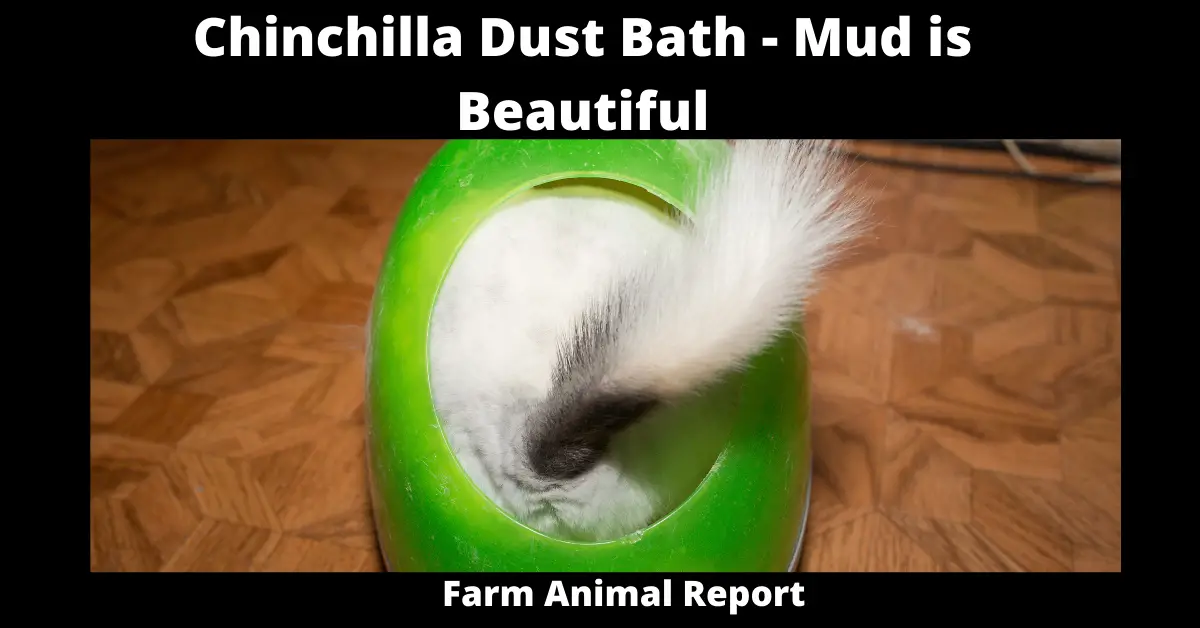Chinchilla dust bath
Chinchilla Dust Bath – Chinchillas are adorable, fluffy pets with the softest fur you’re likely to touch. Their unique fur is exceptionally soft due to an abundance of delicate hair follicles. Their dense coat, which contains up to 80 hairs per follicle, is not intended to be wet because it can be hard to totally dry. The best way to keep their fur healthy and clean is to provide your Chinchilla with the resources necessary to self-clean. While humans require water and soap, these animals only need a bath container filled with the appropriate dust or sand. Dust baths are a chinchilla’s method of maintaining a clean and healthy environment.
Dust baths are necessary for chinchillas to maintain their soft fur and to balance their naturally oily skin. Chinchillas roll in volcanic ash to stay clean in their native South America, which is why they require a unique process in areas devoid of this ash.
Additionally, Chinchillas have up to 60 hairs per follicle (humans have only one hair per follicle), enabling them to retain body heat at high altitudes. Due to the specialized fur, it is prone to clumping, and if a chin does not receive an adequate number of dust baths, the skin may become irritated.
If you’re a first-time chin owner, one of the first things you’ll notice about these pets is their cleanliness and lack of odor. Giving your Chinchilla a dust bath regularly will help keep it clean and remove excess oil, dirt, and moisture from its coat.
Why Chinchillas Need Dust Baths?
A consistent dust bath is a must-have for all chinchillas. Taking a vigorous dust bath is a natural behavior for chinchillas and is one way they keep their lush coats clean and healthy. Not only does a dust bath help keep chinchillas‘ thick fur smooth and silky, but it is also believed to be relaxing and enjoyable for them. Chinchillas genuinely immerse themselves in their baths, rolling and flipping freely in the dust. If you’ve never seen a chinchilla in a dust bath, do some research and find some videos of them moving around in one.

Dust for Chinchilla Baths
Always bathe your Chinchilla with store-bought chinchilla dust. This dust is explicitly formulated for chinchillas and is intended for this purpose. When chinchillas roll in this dust, it penetrates their coats to the skin, absorbing oil and dirt from the fur and keeping the coat clean. While other powders or sands may appear or feel similar, they will not perform in the same way. Chinchilla dust is formulated to replicate the conditions they would encounter in their natural habitat (they use volcanic pumice). Dust should be at least two inches deep in whatever container you use to allow the Chinchilla to roll effectively.
How does Chinchilla Bathe in the Wild?
Chinchillas bathe successfully in the wild, utilizing all-natural resources such as volcanic ash or Andean Clay found throughout their range. Chinchillas will vigorously roll around in the dust, much like they would in a homemade dust bath. Chinchillas in the wild lack the luxury of a ready-made dust bath and must carefully select bathing locations.
You will notice that most wild Chinchillas will spend time locating the appropriate location and resources for bath time. Volcanic Ash is a prevalent ingredient in Chinchilla bathing activities and is frequently found in their natural habitat in Chile’s Andes Mountains.
It is primarily composed of rock, mineral, and volcanic glass fragments formed during volcanic eruptions. Volcanic ash is excellent for dispersing natural oils and cleaning the thick Chinchilla coat of dirt and debris. This is one of the primary reasons Chinchillas prefer this substance for bathing. Andean Clay is also a popular bathing substance for Chinchillas, as it has a similar effect to volcanic ash. It is widespread throughout the Andes Mountains, making it easy to locate for our wild Chinchillas friends.
Chinchillas roll around in the ash or Clay in the same way they would in a dust bath at home. This is why Chinchilla’s dust baths were developed for domesticated Chinchillas in an attempt to replicate the type of bath they would encounter in the wild.
How Often Do Chinchillas Bathe in the Wild?
Chinchillas must not have consistent access to a dust bath in a domesticated environment. This is large because they are prone to use it excessively out of boredom.
If your Chin bathes excessively, it is likely to irritate their delicate skin, causing it to become dry and flaky.
It’s effortless for a Chinchilla to become bored, which is why it’s critical they receive adequate exercise and only have limited access to a dust bath. So how do Chinchillas conserve their resources in the wild? In a nutshell, wild Chinchillas are rarely bored. They have plenty to do, places to visit, and opportunities for much-needed exercise.
They do so on their own. For Chinchillas, having a dust bath serves a purpose. They are unlikely to bathe as frequently as they might in captivity when access is unlimited, and boredom becomes a factor.

Although little study has been conducted on the exact frequency with which Chinchillas bathe in the wild, it is safe to believe that they will avoid bathing excessively or unnecessarily under natural conditions.
Chinchillas in the wild are likely to bathe between two and four times per week, a frequency that is very similar to that of domesticated Chinchillas.
Science of Dust Baths for Animals
Dust bathing, alternatively referred to as sand bathing, is an animal behavior that involves rolling or moving around in the dust, dry earth, or sand, most likely to remove parasites from fur, feathers, or skin. Dust bathing is a maintenance behavior that a wide variety of mammalian and avian species engage in. Like bathing in water or wallowing in mud, dust baths are necessary for some animals to maintain healthy feathers, skin, or fur. Some mammals may use dust bathing to transmit chemical signals (or pheromones) to the ground that denote an individual’s territory.
Science of Chinchilla Fur
Chinchillas are rodents that are indigenous to northern Chile’s Andes Mountains. Chinchillas, which are frequently kept as pets, are also prized for their luxuriously soft fur and were nearly driven to extinction due to demand. According to The Merck Veterinary Manual, chinchilla fur was originally mottled yellow-gray in the wild. However, other colors have become more prevalent through selective breeding, including silver, yellow-gray, bluish-gray, white, beige, and black. Each hair, regardless of the color of the chinchillas, ends in a black tip.
The Chinchilla’s ancestors were among the first rodents to infest South America, first appearing around 41 million years ago. Chinchilla fur became fashionable in the 1700s, and by 1900, the animals had been hunted nearly to extinction. Argentina, Bolivia, Chile, and Peru all prohibited the hunting of wild chinchillas around that time. According to the Chinchilla Chronicles website, an American mining engineer named Mathias F. Chapman obtained special permission from the Chilean government in 1923 to import chinchillas into the United States. Almost every pet chinchilla in the United States today is a direct descendant of Chapman’s 11 chinchillas.
How Many Times a Week should I give my Chinchilla a Dust Bath?
How frequently you make the dust bath available to your chinchillas is highly dependent on your location. At least two to three times a week, your Chinchilla should receive a dust bath. Check your Chinchilla’s skin frequently for signs of flaking, which may indicate that it is too dry or that it is bathing too often. If they are itching and scratching, this is another indication that their skin is too dry. Generally, in more humid climates, you will need to allow them to bathe more frequently, while in arid climates, you will need to enable them to bathe less regularly.
If you live in a hotter, more humid climate, your chinchillas may require daily or biweekly bathing. If you live in cooler and drier weather, they will need bathing only a couple of times a week. It’s critical to consider your climate when determining how frequently to make the dust bath accessible to your chinchillas. For example, if you live in a cooler, drier climate and bathe your chinchillas daily, their skin can become extremely dry and their fur brittle and weak.
The same is true for climates that are hotter and more humid. If chinchillas are only given dust baths twice a week, excess moisture and oil will accumulate in their fur, resulting in mold and fungal infections.
How to give my Chinchilla a Dust Bath
To begin the dust bath, you’ll need a plastic dishpan or container (approximately 12″ long by 6″ deep and wide, or with enough room for your Chin to breathe!). Additionally, you can purchase a dedicated chinchilla bathhouse (a plastic container with a spherical bottom and a roof-shaped top) online or at a local animal supply store; these are excellent options for containing both the dust and your pet and are frequently attached to the inside of your Chinchilla’s cage.
Chinchilla dust, the bath’s primary component, is also available online and in pet stores. Please keep in mind that sand is not the same as chinchilla dust; using sand may cause severe irritation to your pet’s skin and eyes, as well as damage to its fur.
Generally, dust baths should be given to your Chin about twice a week, as excessive access may contribute to its skin drying out. How to dust bathe your Chinchilla:
- To begin, dust your container or bathhouse to a depth of approximately 2 inches.
- Once the “bath” is established, place your Chinchilla in the container.
The great news is that this is the point at which your role as a human being ends and your Chin takes over. “They typically know what to do and just roll,” said Hess, a bird, and exotic pet specialist. Allow your pet to take a bath to keep its coat clean and fresh.

It would help if you replaced the dust in your chinchilla dust bath at least once a week, Hess advised, noting that the dust can become dispersed after a few baths. When dust begins to clump or appears less-than-fresh, it’s time for a change.
Why Chinchilla Sneezing after a Dust Bath?
Dust bathing is a typically vigorous activity, and the dust spreads widely. Due to the fineness of the dust, it can get up the Chinchilla’s nose, resulting in sneezing. Thus, while this is not an allergic reaction, the dust itself may be causing the sneezing – this is entirely normal and should subside after a few sneezes. Enclosed dust baths may be beneficial, as they contain the dust.
Unfortunately, some of the available dust types are not as pure as they could be, resulting in allergic reactions. Ideally, you should seek out a reputable supplier of fine chinchilla dust but never use sand. If the symptoms occur only after dust bathing, try a different brand/type of dust; they may be allergic to that one.
Should you leave Dust Baths in a Chinchilla Cage?
Provide your Chinchilla with a dust bath twice or three times a week, preferably in the evening when chinchillas are most active. Allow 10 to 15 minutes for the dust bath to soak in the cage. If left for an extended period, the Chinchilla may become obsessed with the dust out of boredom, and excessive use may cause its skin to become too dry.
Additionally, if the dust is left in the cage for an extended period, the Chinchilla can use it as a litter box. Provide dust baths on a more frequent basis during humid weather. Reduce bathing frequency and duration of your Chinchilla scratches excessively or has dry, flaky skin.
Why can you not get Chinchilla Wet?
Your Chinchillas should not be allowed to get wet because their dense fur is tough to dry, which increases the risk of fungus growth. However, there may be times when you must wash a chinchilla quickly to avoid infection or chemical burns.
Chinchillas and water do not mix well. Chinchillas have incredibly dense fur and will take an extended period to dry if exposed to excessive water. This is because moisture can permeate their undercoats deeply. If this moisture is not removed, your Chinchilla may develop fungus and bacterial infections, which can wreak havoc on their skin.
While we should always avoid getting a chinchilla wet, there will be occasions when a quick water bath is necessary. For instance, if your Chin’s fur is covered in potentially hazardous substances such as oil, cream, or even pee and wet poo, wiping and dust bathing may be ineffective.
If you’ve exhausted all other options and determined that a quick rinse under running water is the most appropriate way to clean up the mess, go ahead. Bear in mind that pee-burn infections are far riskier than simply wetting your Chinchilla for some seconds.
What to do if Chinchilla gets wet?
Towel dry
If your Chinchilla gets wet accidentally, quickly wipe the water off its body with a piece of cloth. If he appears fearful, provide him with some chinchilla chew toys to divert his attention away from the wet body.
Following that, gently wrap the cloth around the Chinchilla’s body to allow the cloth to continue absorbing water while preventing the Chinchilla from losing temperature too quickly.
Blow-dry
You can also blow dry a wet chinchilla with a hairdryer (it may be faster this way!). Keep the dryer at least half a meter away from your pet and set it to the lowest heat setting possible.
What Health Benefits do Chinchillas get from Dust Baths?
The Chinchilla’s fondness for dust baths is one of the most fascinating and amusing characteristics. These furry creatures have been observed rolling around in fine sand and volcanic ash in the wild, either to groom themselves or simply for fun. This natural activity helps them maintain their famed fur’s cleanliness, plushness, and health. Compared to their rodent and mammalian relatives, the Chinchilla’s hair follicles are relatively thick, holding up to approximately 60 hairs. For other animals, each follicle contains between one and two hairs. The only material capable of penetrating the Chinchilla’s dense coat during grooming is the finest dust.
Chinchillas have evolved to adapt to their harsh natural environment as a result of their arid natural habitat. Because they are unable to sweat, their thick fur assists in insulating their bodies. Rather than that, blood rushes to their ears to keep them cool. Their coats contribute significantly to their protection from extreme temperatures. Additionally, the thickness protects their sensitive skin from parasites and other irritants.
4 Health Problems if Chinchillas do not get Dust Baths?
Chinchillas require daily dust baths to maintain their fur in top condition. Without a dust bath, their fur can become matted due to the oils their skin naturally produces. Select a dust bath large enough for your chinchillas to roll around in. Owners should always brush up on chinchilla care. If chinchillas are not provided with adequate dust baths or are bathed too frequently, several health concerns may arise.
1. Hair loss
This is typically caused by not replacing dust frequently enough, among other factors. Dust that is recycled excessively, meaning it is sifted for waste and not replaced, can result in actual fur disorders. Occasionally, these disorders result in significant bald patches, and the fur may not regrow.
2. Dry skin
Excessive dust bathing frequently results in drier skin. So, it is important to keep a close eye on your chinchillas for the first signs of this skin disorder. On human scalps, you may notice small flakes resembling dandruff. If this occurs, reduce the frequency of dust baths until their skin returns to normal.
3. Fungal infections
Without frequent dust baths, your chinchillas can develop serious fungal infections. When the fur contains an excessive amount of moisture and oil, it can act as a breeding ground for fungus and bacteria. Typically, fungal infections take one of two forms. Occasionally, they will cause the Chinchilla’s fur to fall out, exposing the Chinchilla’s irritated, pink skin beneath. This is most prominent in the face, eye, and genital regions. The other most prevalent fungal infection affects the hair, not the skin. This type causes the hair to become extremely frail and even break. If the infection becomes severe enough, the whiskers may begin to fall out as well.
To treat these infections, take your Chinchilla to an exotic animal veterinarian. Typically, they will prescribe an antifungal powder.
4. Hairballs
When chinchillas take dust baths, they remove excess hair and moisture, and oil from their fur. Without adequate dust baths, excess hair can be consumed during the grooming process.
Hairballs can form if an excessive amount of hair is consumed. Because chinchillas cannot vomit or regurgitate, hairballs can cause severe pain, lethargy, depression, and an inability to eat. It is recommended that you take your chinchillas to the veterinarian if they begin to exhibit these symptoms.
Components of Chinchilla Dust Baths
Discover an all-natural, high-quality chinchilla dusting powder. This item is available at a local pet retailer. Chinchilla Dust is a fine gray sand-like substance. Chinchilla Bath Sand is an excellent alternative to Chinchilla Dust. This is composed entirely of natural volcanic mountain pumice. It is virtually dust-free and straightforward to operate.
Along with the sand or dust, chinchillas require a bathhouse. This is a house made of plastic or ceramic that collects dust or sand. In these enclosed bathhouses, chinchillas will flip, spin, and take a dust bath. Having an enclosed bathhouse minimizes mess and ensures that the Chinchilla comes into complete contact with the dust, allowing them to clean their coats properly.
Fill the bottom of this sturdy bathhouse for your pet with about a half-inch to two-inch of fine dust or sand. The amount used will be determined in large part by the size of your Chinchilla.
DIY Materials that can be used for Chinchilla Dust Baths?
Construct a dust bath for your Chinchilla! For the primary component of the dust bath mixture, choose either volcanic ash or silver sand. Incorporate a trace of Fuller’s earth into the ash or sand. Fill the dust bath bowl of your Chinchilla with the material until it is about one inch thick. Allow your pet to use the bath bowl for up to an hour before removing it from the cage.
Final Thoughts
Dust baths are critical for maintaining the cleanliness of your Chinchilla’s dense and thick coat. It would help if you dusted bathe your Chinchilla twice to three times per week. These animals clean themselves with dust in the wild, which they do instinctively when given a dust bath by their owner.
Choose a deep bowl large enough for your Chinchilla to roll around in freely. Dust the bottom of the bowl with a two-inch layer of dust before adding your pet. Each of these baths should last approximately five to ten minutes. Ensure that you purchase dust that is formulated specifically for bathing chinchillas.
Bathing your Chinchilla is never a good idea, as their fur retains moisture for extended periods. A water bath may result in a bacterial or fungal infection in your pet. After each dust bath, thoroughly clean the bowl to maintain your pet’s overall hygiene and health.


